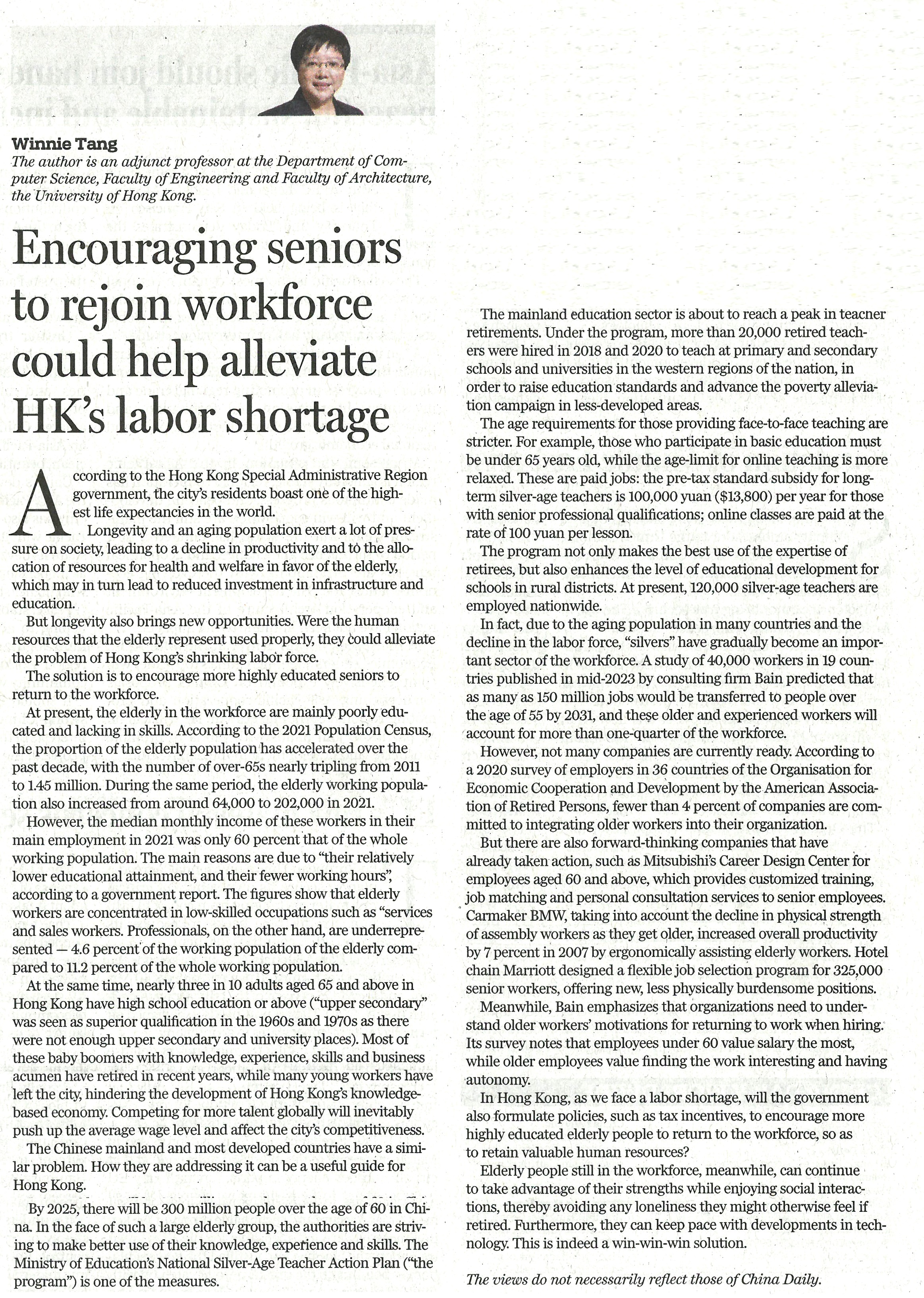網上版請按此

Encouraging seniors to rejoin workforce could help alleviate HK's labor shortage
According to the Hong Kong Special Administrative Region government, the city's residents boast one of the highest life expectancies in the world.
Longevity and an aging population exert a lot of pressure on society, leading to a decline in productivity and to the allocation of resources for health and welfare in favor of the elderly, which may in turn lead to reduced investment in infrastructure and education.
But longevity also brings new opportunities. Were the human resources that the elderly represent used properly, they could alleviate the problem of Hong Kong's shrinking labor force.
The solution is to encourage more highly educated seniors to return to the workforce.
At present, the elderly in the workforce are mainly poorly educated and lacking in skills. According to the2021 Population Census, the proportion of the elderly population has accelerated over the past decade, with the number of over-65s nearly tripling from 2011 to 1.45 million. During the same period, the elderly working population also increased from around 64,000 to 202,000 in 2021.
However, the median monthly income of these workers in their main employment in 2021 was only 60 percent that of the whole working population. The main reasons are due to "their relatively lower educational attainment, and their fewer working hours", according to a government report. The figures show that elderly workers are concentrated in low-skilled occupations such as "services and sales workers. Professionals, on the other hand, are underrepresented— 4.6 percent of the working population of the elderly compared to 11.2 percent of the whole working population.
At the same time, nearly three in 10 adults aged 65 and above in Hong Kong have high school education or above ("upper secondary" was seen as superior qualification in the 1960s and 1970s as there were not enough upper secondary and university places). Most of these baby boomers with knowledge, experience, skills and business acumen have retired in recent years, while many young workers have left the city, hindering the development of Hong Kong's knowledge-based economy. Competing for more talent globally will inevitably push up the average wage level and affect the city's competitiveness.
The Chinese mainland and most developed countries have a similar problem. How they are addressing it can be a useful guide for Hong Kong.
By 2025, there will be300 million people over the age of 60 in China. In the face of such a large elderly group, the authorities are striving to make better use of their knowledge, experience and skills. The Ministry of Education’s National Silver-Age Teacher Action Plan ("the program") is one of the measures.
The mainland education sector is about to reach a peak in teacher retirements. Under the program, more than 20,000 retired teachers were hired in 2018 and 2020 to teach at primary and secondary schools and universities in the western regions of the nation, in order to raise education standards and advance the poverty alleviation campaign in less-developed areas.
The age requirements for those providing face-to-face teaching are stricter. For example, those who participate in basic education must be under 65 years old, while the age-limit for online teaching is more relaxed. These are paid jobs: the pre-tax standard subsidy for long-term silver-age teachers is 100,000 yuan ($13,800) per year for those with senior professional qualifications; online classes are paid at the rate of 100 yuan per lesson.
The program not only makes the best use of the expertise of retirees, but also enhances the level of educational development for schools in rural districts. At present, 120,000 silver-age teachers are employed nationwide.
In fact, due to the aging population in many countries and the decline in the labor force, "silvers" have gradually become an important sector of the workforce. A study of 40,000 workers in 19 countries published in mid-2023 by consulting firm Bain predicted that as many as 150 million jobs would be transferred to people over the age of 55 by 2031, and these older and experienced workers will account for more than one-quarter of the workforce.
However, not many companies are currently ready. According to a2020 survey of employers in 36 countries of the Organisation for Economic Cooperation and Development by the American Association of Retired Persons, fewer than 4 percent of companies are committed to integrating older workers into their organization.
But there are also forward-thinking companies that have already taken action, such as Mitsubishi's Career Design Center for employees aged 60 and above, which provides customized training, job matching and personal consultation services to senior employees. Carmaker BMW, taking into account the decline in physical strength of assembly workers as they get older, increased overall productivity by 7 percent in 2007 by ergonomically assisting elderly workers. Hotel chain Marriott designed a flexible job selection program for 325,000 senior workers, offering new, less physically burdensome positions.
Meanwhile, Bain emphasizes that organizations need to understand older workers' motivations for returning to work when hiring. Its survey notes that employees under 60 value salary the most, while older employees value finding the work interesting and having autonomy.
In Hong Kong, as we face a labor shortage, will the government also formulate policies, such as tax incentives, to encourage more highly educated elderly people to return to the workforce, so as to retain valuable human resources?
Elderly people still in the workforce, meanwhile, can continue to take advantage of their strengths while enjoying social interactions, thereby avoiding any loneliness they might otherwise feel if retired. Furthermore, they can keep pace with developments in technology. This is indeed a win-win-win solution.
Dr. Winnie Tang
Adjunct Professor, Department of Computer Science, Faculty of Engineering; Department of Geography, Faculty of Social Sciences; and Faculty of Architecture, The University of Hong Kong